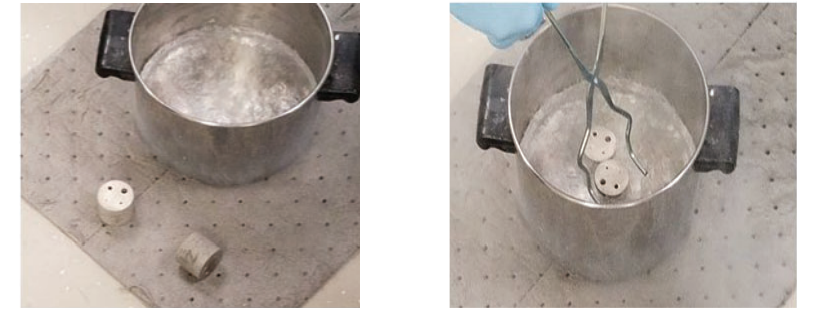Researchers from the University of Texas at El Paso explore EBM powder removal in the recently published ‘Analysis of Powder Removal Methods for EBM Manufactured Ti-6AL-4V Parts.’ While the benefits of 3D printing and additive manufacturing abound, there are still challenges, with numerous obstacles that are often unique to specific techniques. In the case of electron beam powder bed fusion (EBPBF), users may find it challenging to deal with trapped powder that is not completely sintered.
As powder becomes trapped inside parts, users are tasked with finding ways to remove it so the quality of the prototype or part is not compromised (one example of a workaround would be the use of creating vents to remove the unused powder with a pump). In this study, the researchers analyzed numerous ways to extract unused powder from channels and hollow areas fabricated with Ti-6Al4V.

(a) CAD cylinder design with straight channel features, (b) CAD cylinder design with curved channel features, and (c) Additive Manufactured Cylinder.
Two different cylinders were used in the study—one with straight channels, and one with curved, with samples 3D printed on an ARCAM A2X.
The researchers used the following methods of evaluation:
- Powder recovery system
- Ultrasonic
- Ultrasonic with mechanical impact
- Vapor blast
- Chemical etching
- Liquid nitrogen with ultrasonic
Fourteen parts were created overall—seven curved and seven straight—and were subjected to PRS (an auxiliary machine supplied with the Arcam 3D printer) methodology first.

(a) Solid cylinder build to calculate the density of Ti-6Al-4V after EPBF, (b) CAD
model of the cylinder, and (c) the mass properties results from SolidWorks 2018.
“Each described research method was used on one curved-channel cylinder and one straight-channel cylinder,” stated the researchers. “All of the samples were weighed before and after all powder removal methods were applied.”
“After the build, each part was individually cleaned with the PRS to remove all sintered powder from its walls, measured to determine its volume, and weighed to calculate its corresponding density. The average of the three calculated values resulted in an as-built effective density of 4.2691 g/cm3. This calculated density was used in the CAD mathematical model to have the CAD software calculated mass reflect a result, more accurate to a real printed component.”

(Left) Parts before they are submerged inside a pot with liquid nitrogen. (Right)
Parts submerged inside a pot with liquid nitrogen.
Overall, PRS was most effective in removing trapped powder when the part was removed from the machine; however, the researchers noted that upon testing all methodologies, they found the following to be most efficient:
- Ultrasonic
- Ultrasonic and mechanical impact
- Liquid nitrogen and ultrasonic
“It is true that during the building process the sintered powder plays a vital role as support for the final printed component but imposes design limitations that do not allow to have the full advantage of this Additive Manufacturing technology. From the results obtained, the PRS is the most effective method to remove the sintered powder; however, after several iterations, the effectiveness comes to a stall. Ultrasonic, and Liquid Nitrogen & Ultrasonic are methods that can remove more sintered powder from the channels after the PRS,” concluded the researchers.
“Ultrasonic waves can travel through the part, allowing it to reach the channels, while liquid nitrogen can easily access the channels directly and adapt to the channel form. This preliminary work shows that there are methods that can improve the removal of the sintered powder.”
Researchers, manufacturers, and users continue to contend with and work to refine materials and techniques in 3D printing and additive manufacturing, from advanced depowdering systems to new control systems, vacuum cleaners for powder removal, and more.
What do you think of this news? Let us know your thoughts! Join the discussion of this and other 3D printing topics at 3DPrintBoard.com
[Source / Images: ‘Analysis of Powder Removal Methods for EBM Manufactured TI-6AL-4V Parts’]Subscribe to Our Email Newsletter
Stay up-to-date on all the latest news from the 3D printing industry and receive information and offers from third party vendors.
You May Also Like
Industrial Giant Ingersoll Rand Leads $19M Round Backing Inkbit’s AI-Driven 3D Printing
Inkbit, the Massachusetts-based original equipment manufacturer (OEM) of multi-material, AI-integrated 3D printers, has closed a $19 million financing round. Ingersoll Rand, a US giant in the industrial equipment sector, led...
3D Printing Unpeeled: Digital FDM Filament for Functional Gradients
Just published in Nature, a paper by a Seoul National University team looks at “3D printing with a 3D printed digital material filament for programming functional gradients.” Sang-Joon Ahn, Howon...
3D Printing Unpeeled: $5000 Cold Spray 3D Printer, Roland DGA & Living Materials
The AeroForge is a $5000 cold spray metal printer for copper made by a student team at Rice University. In a paper for ACS Central Science a team from Nanjing...
3D Printing News Briefs, April 27, 2024: Research, Digital Dentistry, Cycling, & More
We’re starting today’s 3D Printing News Briefs with some research into 3D printed luminescent quantum-dot polymer architectures and free-form laser beam shaping, and then on to an open source 4-axis...

































